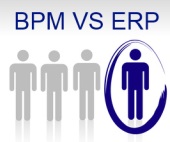BPM vs ERP
BPM : To complete the ERPs scope
To complete the scope of your ERPs or business applications, the BPM can automate:
|
- key business processes, automating them would be a visible and fast gain but these processes don’t correspond to the current scope of your ERPs or business applications, their deployment would mean purchasing new business solutions and their cost would be disproportionate regarding the actual number of processes or users concerned.
Example: you use an ERP for financial and accounting matters, you would like to reduce your purchasing costs and the processing time of your supplier invoices without investing in an expensive ERP of purchase. So you decide to deploy, with a BPM tool, a workflow to follow and check your purchase requests and a process to dematerialize and manage your invoices.
Other example: you use an ERP to manage your sales, the size of your sales force team is reduced, you lose many customer inbound calls and your customers claims aren’t correctly followed. To improve quickly the satisfaction of your customers, you decide to implement, with a BPM tool, some key processes such as a process of inbound calls and another process of customer claims management.
Other example : you have a payroll software, but to increase your efficiency and improve employee satisfaction, you would need to automate also several HR processes: management of newcomers, employees expenses, sales incentives, annual assessments ...
- cross-functional business processes involving several blocks of the information system or many actors: customers, suppliers, partners ...
Example: You want to implement an order and customer delivery process involving the entry of an order by the customer on a portal, a control of the product availability in SAP, tracing the order in the CRM tool, monitoring the delivery in SAP, in case of processing delay, triggering alert within the CRM tool and sending alert to the customer ... You decide to implement a BPM process to articulate and monitor these operations in order to optimize processing times and to improve customer satisfaction.
Example: You want to implement a customer delivery process including an order entry by the customer on a portal, a control of product availability at suppliers, the research and the booking of an available carrier... You decide to implement a BPM process to articulate and monitor these interactions to optimize processing times and improve customer satisfaction.
- complex workflows that you cannot realize with your current tools for technical, organizational or financial reasons
Example: your customer orders, before being validated, have to be checked by a few people and there are a large number of checks to do. These checks are unique to your branch and are not the same in the other group subsidiaries; they aren’t implemented in the Group IT solution. So you decide to deploy a BPM process to manage them.
- document processes involving many actors
Example: in the area of insurance, claims processing requires to collect and manage numerous documents and involves several actors: the policyholder, managers, experts ... The implementation of a document process with a BPM tool can improve this process, articulate the interactions, reduce processing times and improve the satisfaction of policyholders.
|





